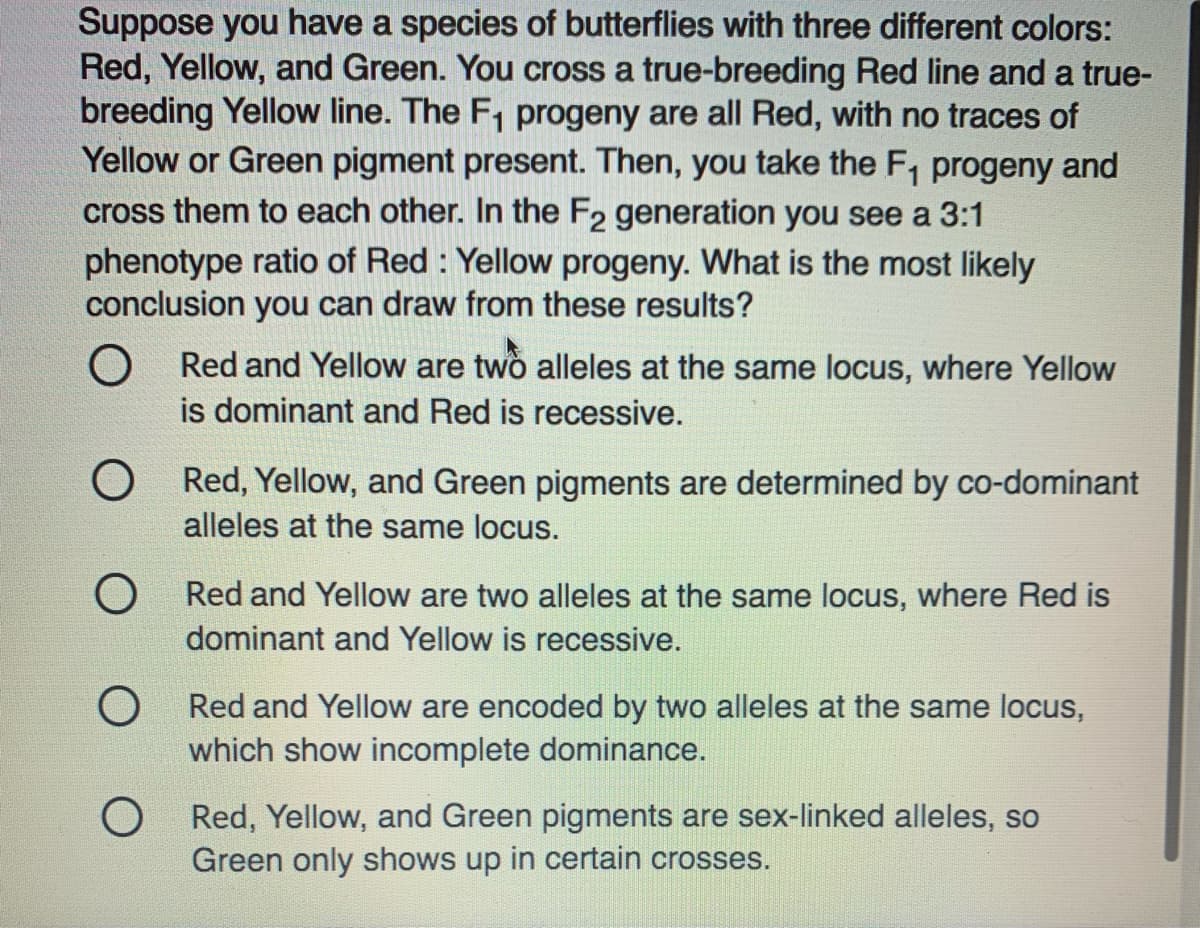Vith three COlors: Red, Yellow, and Green. You cross a true-breeding Red line and a true- breeding Yellow line. The F, progeny are all Red, with no traces of Yellow or Green pigment present. Then, you take the F, progeny and cross them to each other. In the F2 generation you see a 3:1 phenotype ratio of Red : Yellow progeny. What is the most likely conclusion you can draw from these results?
Vith three COlors: Red, Yellow, and Green. You cross a true-breeding Red line and a true- breeding Yellow line. The F, progeny are all Red, with no traces of Yellow or Green pigment present. Then, you take the F, progeny and cross them to each other. In the F2 generation you see a 3:1 phenotype ratio of Red : Yellow progeny. What is the most likely conclusion you can draw from these results?
Human Heredity: Principles and Issues (MindTap Course List)
11th Edition
ISBN:9781305251052
Author:Michael Cummings
Publisher:Michael Cummings
Chapter3: Transmission Of Genes From Generation To Generation
Section: Chapter Questions
Problem 17QP
Related questions
Question
Can you please find the best conclusion answer for this problem?

Transcribed Image Text:Suppose you have a species of butterflies with three different colors:
Red, Yellow, and Green. You cross a true-breeding Red line and a true-
breeding Yellow line. The F, progeny are all Red, with no traces of
Yellow or Green pigment present. Then, you take the F, progeny and
cross them to each other. In the F2 generation you see a 3:1
phenotype ratio of Red : Yellow progeny. What is the most likely
conclusion you can draw from these results?
Red and Yellow are two alleles at the same locus, where Yellow
is dominant and Red is recessive.
O Red, Yellow, and Green pigments are determined by co-dominant
alleles at the same locus.
O Red and Yellow are two alleles at the same locus, where Red is
dominant and Yellow is recessive.
O Red and Yellow are encoded by two alleles at the same locus,
which show incomplete dominance.
O Red, Yellow, and Green pigments are sex-linked alleles, so
Green only shows up in certain crosses.
Expert Solution
This question has been solved!
Explore an expertly crafted, step-by-step solution for a thorough understanding of key concepts.
Step by step
Solved in 2 steps

Knowledge Booster
Learn more about
Need a deep-dive on the concept behind this application? Look no further. Learn more about this topic, biology and related others by exploring similar questions and additional content below.Recommended textbooks for you

Human Heredity: Principles and Issues (MindTap Co…
Biology
ISBN:
9781305251052
Author:
Michael Cummings
Publisher:
Cengage Learning

Concepts of Biology
Biology
ISBN:
9781938168116
Author:
Samantha Fowler, Rebecca Roush, James Wise
Publisher:
OpenStax College

Biology (MindTap Course List)
Biology
ISBN:
9781337392938
Author:
Eldra Solomon, Charles Martin, Diana W. Martin, Linda R. Berg
Publisher:
Cengage Learning

Human Heredity: Principles and Issues (MindTap Co…
Biology
ISBN:
9781305251052
Author:
Michael Cummings
Publisher:
Cengage Learning

Concepts of Biology
Biology
ISBN:
9781938168116
Author:
Samantha Fowler, Rebecca Roush, James Wise
Publisher:
OpenStax College

Biology (MindTap Course List)
Biology
ISBN:
9781337392938
Author:
Eldra Solomon, Charles Martin, Diana W. Martin, Linda R. Berg
Publisher:
Cengage Learning

Biology: The Dynamic Science (MindTap Course List)
Biology
ISBN:
9781305389892
Author:
Peter J. Russell, Paul E. Hertz, Beverly McMillan
Publisher:
Cengage Learning